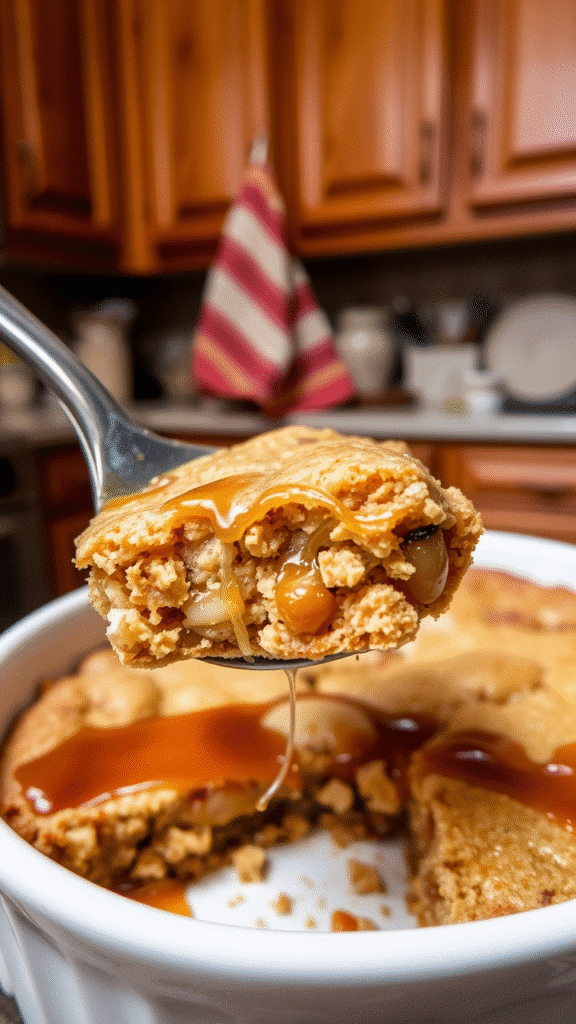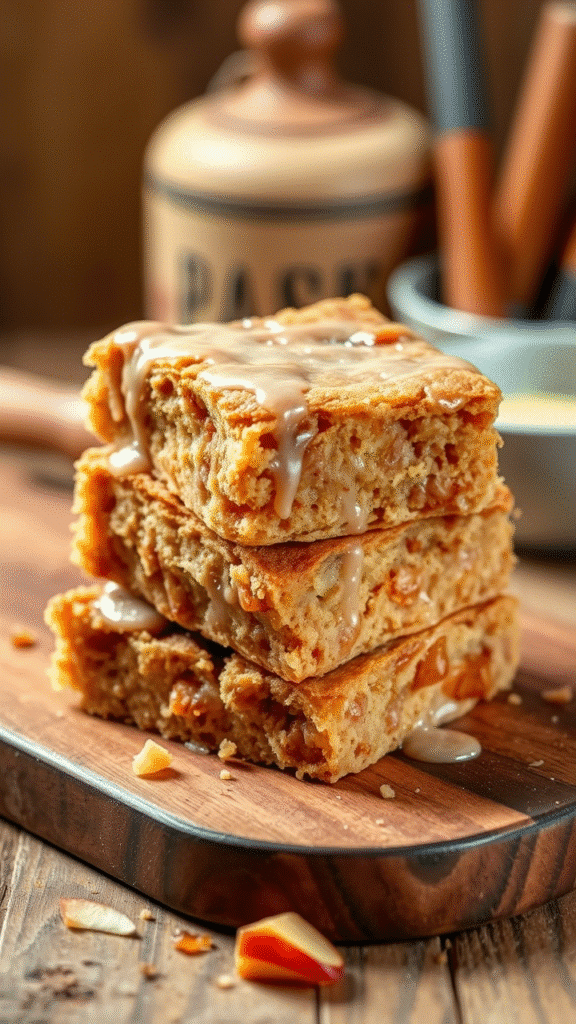Last October, I watched a seasoned pastry chef reduce a room full of culinary students to absolute silence with a single bite of what looked like an ordinary bar cookie. The secret? Maple glazed apple blondies that had been perfected over fifteen years of autumn menu development. That moment taught me something profound about the power of humble ingredients elevated through technique.
These aren’t your grandmother’s apple bars, though they carry that same soul-warming comfort. Maple glazed apple blondies represent the sophisticated evolution of classic bar cookies—where brown butter meets caramelized apples, and pure maple syrup transforms into liquid gold that cascades over tender, chewy squares.
What makes this dessert truly special lies in the marriage of textures and the careful balance of sweetness. The blondie base provides that perfect chew-to-tender ratio, while diced apples offer bursts of tartness and moisture. Then comes the maple glaze—not just sweetness, but complexity with hints of vanilla and that distinctive maple character that can’t be replicated by artificial flavoring.
Ingredients & Substitutions
For the Blondie Base:
- 1 cup (226g) unsalted butter
- 1½ cups (300g) light brown sugar, packed
- 2 large eggs, room temperature
- 2 teaspoons vanilla extract
- 1¾ cups (219g) all-purpose flour
- 1 teaspoon baking powder
- ½ teaspoon fine sea salt
- ¼ teaspoon ground cinnamon
- 2 medium Honeycrisp apples, peeled and diced (about 2 cups)
For the Maple Glaze:
- ½ cup pure maple syrup (Grade A Dark Robust preferred)
- 3 tablespoons unsalted butter
- 1 cup (120g) powdered sugar, sifted
- 2 tablespoons heavy cream
- Pinch of sea salt
The choice of butter quality cannot be understated here. European-style butter with higher fat content creates richer flavor and better texture. If you’re working with standard American butter, consider browning it first—the nutty notes complement both maple and apple beautifully.
Brown sugar serves dual purposes: sweetness and moisture retention. Light brown sugar provides the perfect balance, but dark brown sugar works if you prefer deeper molasses notes. Avoid substituting with white sugar entirely, as you’ll lose that chewy texture that defines a proper blondie.
For apple selection, Honeycrisp offers ideal firmness and sweet-tart balance. Granny Smith works excellent for those preferring more tartness, while Gala or Fuji provide sweeter profiles. Avoid Red Delicious—they turn mushy and lack flavor complexity. The key is using apples that hold their shape during baking.
Grade A Dark Robust maple syrup delivers the most complex flavor for the glaze. Avoid pancake syrup or artificial maple—the difference is dramatic. If pure maple syrup isn’t available, consider making a brown butter syrup as an alternative, though the character changes significantly.
For dietary modifications, gluten-free flour blends work reasonably well, though texture becomes slightly more delicate. Vegan adaptations require careful butter substitution—I recommend a high-quality vegan butter rather than oil to maintain richness.
Step-by-Step Instructions

Preparing the Foundation
Preheat your oven to 350°F (175°C) and line a 9×13-inch pan with parchment paper, leaving overhang for easy removal. This seemingly simple step prevents countless disasters—trust me on the parchment.
Begin by melting butter in a heavy-bottomed saucepan over medium heat. Watch carefully as it transforms from yellow to golden, then to a nutty brown with a fragrant aroma. This takes about 5-7 minutes, and the difference between perfectly browned and burnt happens in seconds. Remove from heat immediately when you smell that nutty fragrance.
Building the Blondie Base
Transfer the browned butter to a large mixing bowl and whisk in brown sugar while the butter is still warm. This technique helps dissolve the sugar partially, creating that characteristic dense-yet-tender texture. The mixture should look slightly glossy and smell incredible.
Add eggs one at a time, whisking thoroughly after each addition. Room temperature eggs incorporate more easily—if you forgot to bring them to temperature, place them in warm water for five minutes. Cold eggs can cause the mixture to seize slightly.
Whisk in vanilla extract, then set aside your whisk. In a separate bowl, combine flour, baking powder, salt, and cinnamon. The cinnamon amount might seem modest, but it should enhance, not overpower, the apple and maple flavors.
The Critical Mixing Stage
Fold the dry ingredients into the wet mixture using a rubber spatula. Mix just until flour disappears—overmixing develops gluten, resulting in tough blondies. The batter should look slightly shaggy but cohesive.
Gently fold in diced apples, ensuring even distribution. Don’t worry if some pieces seem large—they’ll soften during baking and create pockets of concentrated apple flavor.
Baking Perfection
Spread batter evenly in your prepared pan using an offset spatula. The surface doesn’t need to be perfectly smooth—slight irregularities actually create interesting texture variations.
Bake for 28-32 minutes, until the center is just set and edges begin pulling slightly from the sides. The top should be golden brown with a slight spring when lightly touched. Overbaking creates dry blondies, so err on the side of caution.
Crafting the Maple Glaze
While blondies cool, prepare the glaze. Heat maple syrup and butter in a small saucepan over medium heat until butter melts completely. Remove from heat and let cool for two minutes.
Whisk in sifted powdered sugar gradually—lumps are the enemy here. Add cream one tablespoon at a time until you achieve a pourable but not-too-thin consistency. The glaze should coat the back of a spoon but still flow freely.
Finish with a pinch of sea salt, which brightens the maple flavor and adds subtle complexity.
Cooking Techniques & Science
The science behind perfect blondies lies in understanding fat, sugar, and flour interactions. Brown butter contributes both flavor and affects texture through the milk solids that caramelize during heating. These milk solids also add depth that regular melted butter cannot achieve.

Brown sugar’s hygroscopic properties mean it attracts and retains moisture from the air, keeping blondies tender longer than bars made with white sugar. The molasses content also contributes to that characteristic chewy texture through its interaction with proteins in the flour.
The slight underbaking technique I recommend relies on carryover cooking—the residual heat continues cooking the center while preventing the edges from becoming overcooked. This creates that perfect texture gradient from slightly firmer edges to tender centers.
Apple preparation significantly impacts the final product. Dicing to ¼-inch pieces ensures even distribution and prevents large chunks from creating structural weak points. Peeling isn’t absolutely necessary, but it prevents tough skin pieces from disrupting the smooth texture.
Serving & Pairing Suggestions
Present these blondies at room temperature for optimal texture and flavor development. The maple glaze should have set to a beautiful glossy finish that catches light appealingly.

For elegant presentation, cut into precise 2-inch squares using a sharp knife wiped clean between cuts. Dust lightly with cinnamon or arrange on wooden serving boards for rustic charm.
These pair beautifully with vanilla bean ice cream or lightly sweetened whipped cream. For beverage pairings, consider spiced chai, apple cider, or even a light-bodied red wine like Pinot Noir for sophisticated occasions.
Coffee service works excellently—the maple notes complement medium roast coffees particularly well. For something special, try pairing with maple bourbon or a cream sherry.
Conclusion
Maple glazed apple blondies represent everything beautiful about autumn baking—familiar comfort elevated through technique and quality ingredients. The interplay between brown butter richness, apple freshness, and maple complexity creates something truly memorable.
The key to success lies in patience during the browning process, gentle mixing technique, and not overbaking. These simple principles separate good blondies from exceptional ones.
Consider this recipe your foundation for creativity. Try adding toasted walnuts, a hint of cardamom, or even a layer of caramel between the blondie and glaze. The possibilities are endless, but the fundamentals remain constant.
Master this recipe, and you’ll have a dessert that transitions beautifully from casual family dinners to sophisticated entertaining. Sometimes the most impressive desserts are the ones that feel like home.
Frequently Asked Questions?
Q: Can I make these blondies ahead of time?
A: Absolutely. These actually improve after a day, as flavors meld beautifully. Store covered at room temperature for up to four days, or freeze unglazed bars for up to three months. Add glaze after thawing for best results.
Q: Why are my blondies dry instead of chewy?
A: Overbaking is the most common culprit, but using too much flour or overmixing the batter also contributes to dryness. Check your oven temperature with a thermometer—many ovens run hot. Also ensure you’re measuring flour correctly by spooning it into cups rather than scooping.
Q: Can I substitute the maple syrup in the glaze?
A: While pure maple syrup provides the best flavor, you can substitute with honey or brown rice syrup in equal amounts. The flavor profile changes significantly, but the texture remains similar. Avoid corn syrup or artificial maple—the results are disappointing.
Q: How do I prevent the apples from making the blondies soggy?
A: Dice apples into small, uniform pieces and pat them dry with paper towels before folding into the batter. Avoid using overripe apples, which release too much moisture. If your apples seem particularly juicy, toss them with a tablespoon of flour before adding to the batter.
Q: What’s the difference between blondies and brownies?
A: Blondies use brown sugar as their primary sweetener and contain no chocolate, while brownies typically use white sugar and chocolate. This gives blondies their characteristic butterscotch flavor and lighter color. The texture can be similar, but blondies tend to be slightly more tender due to the brown sugar content.

Veronica is a passionate food enthusiast with over three years of experience in exploring and writing about diverse cuisines. Her expertise lies in reviewing restaurants, sharing creative recipes, and discovering the latest food trends. As the voice behind FoodieRecap.com, Anju brings fresh perspectives and culinary insights to her audience.
